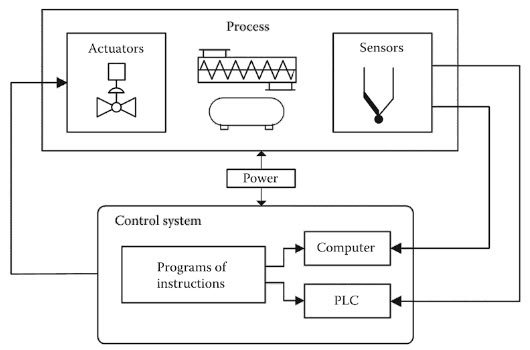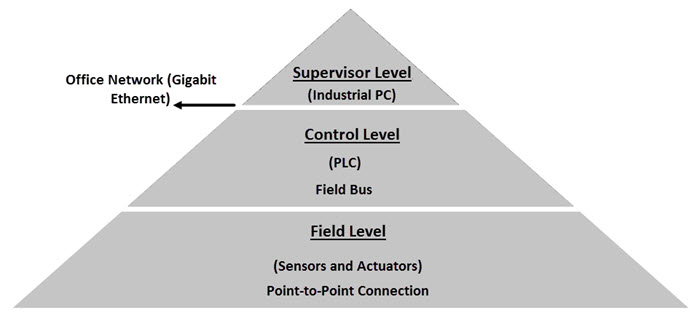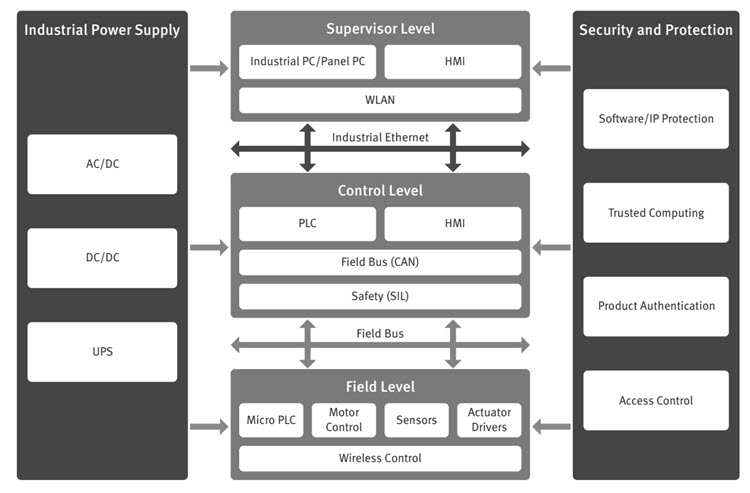Introduction
Since the period of industrial revolution in Britain, there has always been a significant amount of effort into developing complex techniques to help people with different tasks of production. An industrial production process consists of series of machines, through which a combination of raw materials goes through and transform into the final product. Here, the term “machine” can be anything like a motor, drill, conveyor belt, etc. which come under electromechanical devices or chemical machines like ovens, dryers, chemical combustion systems etc. Today, Industrial Automation has taken over the production process in industries and it is very difficult to imagine a production line without automation systems. There are several factors that lead to the implementation of automation system in industrial production like requirement of high-quality products, high expectations in product reliability, high-volume production etc.
What is Industrial Automation?
Industrial Automation is a process of operating machines and other industrial equipment with the help of digital logical programming and reducing human intervention in decision making and manual command process with the help of mechanized equipment. The above definition is definitely not a simple one to understand but let us try to understand what an industrial automation is with the help of a small example.
Example to Understand Industrial Automation
Consider a manual industrial production process, where an operator is observing the temperature of an oven. Assume the task is to reach a certain temperature and maintain that temperature for about 30 minutes. So, the operator has to first adjust the amount of fuel to the oven by controlling a valve to rise the temperature to the desired amount. Once the necessary temperature is achieved, it has to be maintained by constantly adjusting the valve i.e. either increase or decrease the fuel depending on the temperature for the next 30 minutes. Now, with industrial automation, the whole process is taken care of without the help of an operator. First, there is a temperature sensor placed near the oven which reports the temperature to a computer. Now, there is motorized valve, which is also controlled by the computer, for the fuel to be supplied to the oven. Based on the temperature readings from the sensor, the computer will open the valve to allow more fuel in the beginning. Once the desired temperature is achieved, the valve is shutoff. But the computer can open or close the valve, even to allow a tiniest amount of fuel to flow, based on the temperature readings. The timer in the computer will indicate once 30 minutes is up and the computer can completely shut off the system.
The above example may seem vague but it helps in understanding how a typical industrial automation system can be implemented. In the above example, there are absolutely zero human interventions and the whole task is completely carried out by the automation system.
Motivation for Industrial Automation
The term Automation is coined by an Engineer from Ford Motor Company, who were pioneers in industrial automation and manufacturing assembly line. In the beginning, the industrial production process is based on the eyes, hands and brain of a worker, in contrast to modern day sensors, actuators and computers. Originally, the implementation of automation in a production process is focused on replacing a human worker with an independent machine. Initially, these independent machines had to be coordinated by a human supervisor for a smooth production process. But with technological developments in analog and digital control systems, microprocessors and PLCs (Programmable Logic Controllers) and various sensors, it has become very easy to synchronize several independent machines and processes and achieve true industrial automation. With the rise in industrial economy, the business strategies for industrial automation have also changed over time. Now-a-days, the fundamental motivations for implementing industrial automation are:
Increase production Reducing cost, especially, human-related cost Improving the quality of the product Efficient use of raw materials Reduce energy consumption Increase business profits
There are a few secondary motivations for using automation in industrial production process like providing a safe environment for the operator, reducing the environmental pollution, etc.
Levels of Industrial Automation Process
There are several ways to describe the levels of an Industrial Automation Process, but the simplest of all is the following hierarchical triangle of three level representation of a typical Industrial Automation Application.
Supervisor Level
Sitting at the top of hierarchy, the supervisor level usually consists of an Industrial PC, which is usually available as a desktop PC or a Panel PC or a Rack-mounted PC. These PCs run on standard operating systems with a special software, usually provided by the supplier for industrial process control. The main purpose of the software is process visualization and parameterization. A special industrial ethernet is used for communication, which can be Gigabit LAN or any wireless topology (WLAN).
Control Level
The Control Level is the mid-level in the hierarchy and this is the level where all the automation related programs are executed. For this purpose, generally, Programmable Logic Controllers or PLCs are used, which provide real-time computing capability. PLCs are usually implemented using 16-bit or 32-bit microcontrollers and run on a proprietary operating system to meet the real-time requirements. PLCs are also capable of being interfaced with several I/O devices and can communicate through various communication protocols like CAN.
Field Level
The terminal equipment like Sensors and Actuators are categorized into Field Level in the hierarchy. The sensors like temperature, optical, pressure etc. and actuators like motors, valves, switches etc. are interfaced to a PLC through a field bus and the communication between a Field Level device and its corresponding PLC is usually based on a point-to-point connection. Both wired and wireless networks are used for communication and using this communication, the PLC can also diagnose and parameterize various components. Additionally, an industrial automation process system also requires two major systems. They are:
Industrial Power Supply Security and Protection
The power requirements of different systems in different levels of the hierarchy can be extremely different. For example, PLCs usually run on 24V DC, while heavy motors run on either 1-phase or 3-phase AC. So, a wide range of proper input power supply is required for a trouble-free operation. Additionally, there should be security for the software being used to control the PLCs as it can be easily be modified or corrupted. Considering all the above-mentioned levels and their corresponding components, a typical Industrial Automation System will have the following structure.
Types of Industrial Automation Systems
Now that we have seen a little bit about the layout of a typical industrial automation system, let us proceed with the discussion of the different type of Industrial Automation Systems. Industrial Automation Systems are usually categorized into four types.
Fixed Automation System Programmable Automation System Flexible Automation System Integrated Automation System
Fixed Automation System
In a Fixed Automation System, the production equipment is fixed with a fixed set of operations or tasks and there are rarely any changes to these operations. Fixed Automation System is usually used in continuous flow processes like conveyors and mass production systems.
Programmable Automation System
In Programmable Automation System, the sequence of operations as well as the configuration of the machinery can be changed using electronic controls. This system requires a significant amount of time and effort to reprogram the machines and usually used in batch process production.
Flexible Automation System
A Flexible Automation System is usually, always controlled by computers and are often implemented where the product varies frequently. CNC machines are the bet example for this system. The code given by the operator to the computer is unique to a particular job and based on the code, the machine acquires the necessary tools and equipment for the production.
Integrated Automation System
An Integrated Automation System is a set of independent machines, processes and data, all working synchronously under the command of a single control system to implement an automation system of a production process. CAD (Computer Aided Design), CAM (Computer Aided Manufacturing), computer-controlled tools and machines, robots, cranes and conveyors are all integrated using complex scheduling and production control.
Advantages and Disadvantages of Industrial Automation
Advantages
The task performed by human operators involving tedious physical work can be easily replaced. Human operators can avoid working in dangerous production environments with extreme temperatures, pollution, intoxicating elements or radio-active substances. The tasks that are difficult for a typical human operator can be easily done. These tasks include lifting heavy and large loads, working with extremely tiny objects etc. Production is always faster and the cost of the product is significantly less (when compared to the same product that is produced with manual operation). Several quality control checks can be integrated into the production process to provide consistency and uniformity. The economy of the industry can be significantly improved, which has a direct impact on the standard of the living.
Disadvantages
Loss of jobs. Since, majority of the work is done by machines, the requirement for manual labor is very less. All the desired tasks cannot be automated using the current technology. For example, products with irregular shapes and sizes are best left for manual assembly. (This trend seems to be changing with advanced computers and algorithms). It is feasible to use automation for certain process i.e. high-volume production, repeatable and consistent products. The initial cost of implementing an automation system is very high. A set of skilled personnel is always a requirement for maintenance and service.
Comment * Name * Email * Website
Δ








![]()